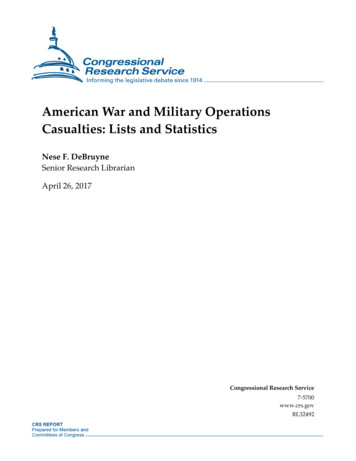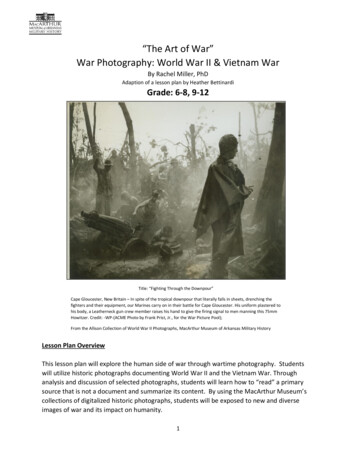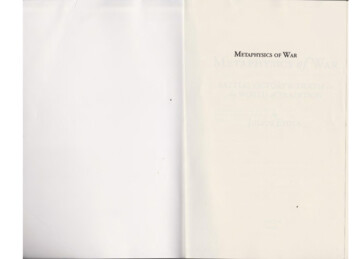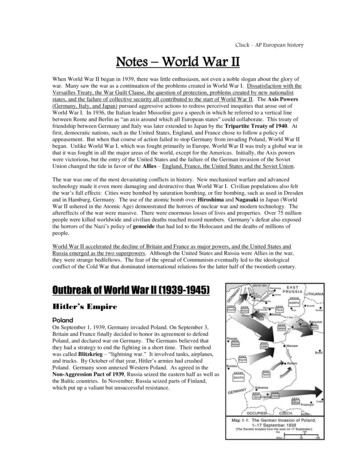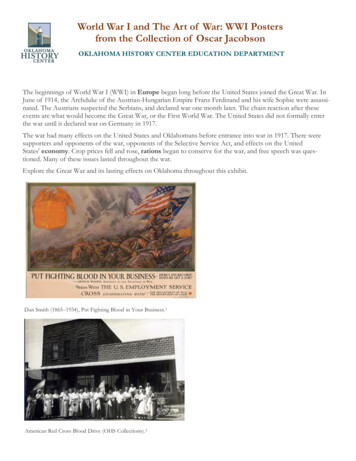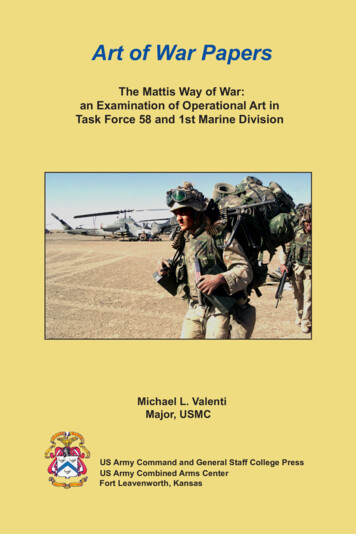
Transcription
Art of War PapersThe Mattis Way of War:an Examination of Operational Art inTask Force 58 and 1st Marine DivisionMichael L. ValentiMajor, USMCUS Army Command and General Staff College PressUS Army Combined Arms CenterFort Leavenworth, Kansas
Cover image: A Marine from the 15th Marine Expeditionary Unit movesto a security position at Forward Operating Base Rhino, Afghanistan,25 November 2001. Photo by Sgt. Joseph R. Chenelly. (DVIC DMSD-06-03033).
The Mattis Way of War:an Examination of Operational Art inTask Force 58 and 1st Marine DivisionMichael L. Valenti, Major, USMCM.M.A.S., Command and General Staff College,Fort Leavenworth, Kansas,2014US Army Command and General Staff College PressUS Army Combined Arms CenterFort Leavenworth, Kansas
Library of Congress Cataloging-in-Publication DataNames: Valenti, Michael L., author.Title: The Mattis way of war : an examination of operational art in TaskForce 58 and 1st Marine Division / Michael L. Valenti, Major, USMC.Other titles: Examination of operational art in Task Force 58 and 1st MarineDivisionDescription: Fort Leavenworth, Kansas : US Army Command and General StaffCollege Press, an imprint of the Combat Studies Institute Press, [2014] Includes bibliographical references and index.Identifiers: LCCN 2015034147 ISBN 9781940804057 (alk. paper)Subjects: LCSH: Mattis, James N., 1950---Military leadership. Operationalart (Military science)--Case studies. Command of troops--Case studies. United States. Navy. Task Force 58--History--21st century. UnitedStates. Marine Corps. Marine Division, 1st--History--21st century. IraqWar, 2003-2011--Campaigns--Case studies. Afghan War,2001---Campaigns--Case studies.Classification: LCC U162 .V28 2015 DDC 956.7044/345--dc23 LC recordavailable at Caution-http://lccn.loc.gov/2015034147First Printing September 2016Layout and Design byElizabeth J. BrownCombat Studies Institute PressUS Army Command and General Staff College Presspublications cover a wide variety of military topics.The views expressed in this publication are those of theauthor(s) and not necessarily those of the Department ofthe Army or the Department of Defense.The seal of the US Army Command and General StaffCollege authenticates this document as an official publication of the US Army Command and General StaffCollege Press. It is prohibited to use this official seal on any republication withoutthe express written permission of the US Army Command and General Staff College Press.ii
AbstractThe generalship, leadership, and operational art of General James N.Mattis, US Marine Corps is examined by using Task Force 58 in Afghanistan as a formative base and then comparing elements of operational art tothe conduct of the 1st Marine Division in Operation Iraqi Freedom, 2003.Mattis draws upon many historical influences that shape his operationaldesign in both campaigns. He puts great effort and focus on ensuring thathis commander’s intent is understood by all his subordinates and uses apreference for a small staff in the planning and execution of his intent. Hemakes heavy use of personally selected liaison officers to form and sustainhabitual relationships with higher and adjacent units. Through the use ofhistorical examples and a refusal to be constrained by doctrine and popular thought he uses innovative approaches in his design. These innovativeapproaches often constitute paradigm shifts with contemporary thoughtand doctrine. A “Mattis Way of War” is postulated in the conclusion whichdraws from his use of history, commander’s intent, and leadership to buildup a capacity, or potential energy, for action in his unit. Once built up, heunleashes this energy utilizing explicit trust in his staff and subordinates.iii
AcknowledgementsI wish to thank my wife, Colleen, for her unrelenting support in thisendeavor. My long nights and weekends sequestered in the basement lefther to care for our children and run the house. She never complained. Tomy children, Mickey and Brigid, thank you for being “good” during the“best year of our lives.” I hope someday my example of hard work anddedication will become apparent to you. Thank you to my in-laws, Kevinand Susan for their frequent trips to Kansas to help my family and keepus sane.Much appreciation and gratitude is felt for a variety of people atCGSC: my fellow Art of War Scholars for the invaluable feedback theyhave given me for this thesis; Dr. Dean Nowowiejski for having the confidence in me to finish this thesis, when I lacked the confidence myself;Colonel John Sullivan, USMC (Ret) for giving me the mentorship andmotivation that only one Marine could give to another; and to my committee members for providing me with feedback and showing remarkablepatience.I wish to thank the United States Marine Corps History Division foraiding me in my research and providing me with a wealth of information,especially Mr. Tom Baughn. Mr. Vincent Goulding of the Marine CorpsWarfighting Lab wrote an article in the Marine Corps Gazette that spurredmy interest in Task Force 58. For all those I forgot to mention, thank you.Within one hour of contacting General Mattis, he responded with awealth of information and offers to assist me in this project. His materialand the interview he honored me with have been invaluable. He is a truesteward of our profession.Finally, I wish to thank my father, Bill, and my mother, Angie, forall the support they have given me and the confidence they have bestowedupon me. My mother’s unexpected death during this thesis dealt a hardblow from which I was not sure I could recover. I am confident that she hasgiven me the strength to pick myself up, is watching over me, and excitedto see me finish and return to my family. The streets to heaven are guardedby United States Marines and no doubt my brothers there embraced herwhen she entered. I love you. Semper Fidelis! Go Navy! Beat Army!iv
ContentspageAbstract. iiiAcknowledgements. ivAcronyms. viiChapter 1 Introduction.1Chapter 2 Task Force 58.11Chapter 3 Commanding General 1st Marine Division 2003.27Chapter 4 Command and Leadership Philosophies.41Chapter 5 Conclusions and hy.69v
FigurespageFigure 1. Marine Air-Ground Task Force.4Figure 2. USS Bataan Amphibious Ready Group.7Figure 3. USS Peleliu Amphibious Ready Group.7Figure 4. Chain of Command.8Figure 5. FOB Rhino and ISBs.17Figure 6. Jersey Drill, LSA Matilda, Kuwait, 27 February 2003.31Figure 7. The Mother of all Terrain Models.32Figure 8. The Push Towards Baghdad.35Figure 9. Mattis Way of War.55vi
AcronymsARGAmphibious Ready GroupCENTCOMUS Central CommandCPCommand PostDODDepartment of DefenseFOBForward Operating BaseISBIntermediate Staging BaseLOCLogistics Operations CenterMAGTFMarine Air Ground Task ForceMEBMarine Expeditionary BrigadeMEFMarine Expeditionary ForceMEUMarine Expeditionary UnitOIFOperation Iraqi Freedomvii
Chapter 1IntroductionOverview and BiographyThis study examines General James N. Mattis’s staffing philosophies,the influence of history on his operational planning and execution, and hisgeneral command and leadership philosophies using Task Force 58 as aformative base. A brief look at his time commanding the 1st Marine Division in Operation Iraqi Freedom (OIF) examines whether his philosophiesand concepts evolved or remained consistent. A chapter dedicated to hiscommand philosophies and leadership explores common themes that werepresent during both periods and their influence on his later generalship.General Mattis is an iconic figure in recent Marine Corps history andis known by many nicknames such as Mad Dog and the Warrior Monk.He gets the latter because of his intense love and study of military history,leadership, and the art of war. He had humble beginnings; born in a smalltown in the Pacific Northwest at the base of the Columbia River whichhad deep-rooted agricultural ties and a nuclear industry. His father was aMerchant Mariner and his mother worked with United States Army intelligence in South Africa. Growing up, his family never had a television, buthad a rather extensive library. He has never married.1After retiring in June of 2013, Mattis completed over 41 years ofservice. He commanded at all levels including Recruiting Station Portland, 1st Battalion, 7th Marines, 7th Marines (reinforced), 1st Marine Expeditionary Brigade, Task Force 58, 1st Marine Division, Marine CorpsCombat Development Command, I Marine Expeditionary Force, US JointForces Command, and US Central Command.2Synopsis of Events Surrounding 9/11In response to the attacks of 9/11, the United States had to determine which military options in its arsenal would be best suited for theinitial campaign in Afghanistan. There was initially much debate amongstPresident George W. Bush and his National Security Council as to theform of America’s initial response. The debate focused between the use ofthe Central Intelligence Agency and the Department of Defense (DOD) tolead the military response. When asked what the military could provide inthe way of developing the campaign, Secretary of Defense Donald Rumsfeld said “very little, effectively.”31
Secretary Rumsfeld had to develop DOD options quickly and relied heavily on the input of two men: General Hugh Shelton, Chairmanof the Joint Chiefs of Staff and General Tommy Franks, Commander ofthe US Central Command (CENTCOM). Rumsfeld’s initial guidance wasfor “something creative between launching cruise missiles and an all-outmilitary operation.”4 In order to meet the intent, General Franks quicklydismissed any Marine Corps option stating, “We can’t make use of theMarines’ amphibious capabilities. Whatever the final shape of the operation, it’ll depend on airlift.”5 In his monograph entitled “US Marines in Afghanistan 2001-2002,” Colonel Nathan S. Lowrey writes, “General Franksmay have been acknowledging that the doctrinal capability of Marine expeditionary units limited amphibious operations to within 200 miles of thePakistani coast.”6By 14 September 2001, the DOD had no options except for a cruisemissile strike. General Franks summarized by stating, “The long poles ofthis operation will be access and sustainment. Any operation we conductin Afghanistan will be dependent on airlift thousands of tons a day.”7Pressured to come up with courses of action the CENTCOM staff cameup with the a four part plan: (1) Tomahawk missile strikes against Talibanand al-Qaeda forces in Afghanistan; (2) After the missile strike, conducta three to ten day air war utilizing US Air Force bombers; (3) Followingthe missile and bomber attacks, put “boots on the ground” consisting ofspecial operations forces from the Army, Navy, Air Force, and Central Intelligence Agency; and (4) Prosecute the first three options simultaneouslythen introduce conventional US Army and US Marine ground forces.8Bush wanted something more than the military plan presented andinitially dismissed the DOD’s approach calling it “unimaginative.”9 On17 September 2001, President Bush approved a separate Central Intelligence Agency option developed by Director George Tennant that involveda worldwide media plan and partnership with the Northern Alliance. Hedirected Secretary of State Colin Powell to issue an ultimatum to the Taliban “demanding that they turn over Osama bin Laden or suffer the consequences.”10 The consequences would take the form of the missile strikesand boots on the ground mentioned above. Rumsfeld was still pressuringthe DOD to break the mold on conventional airlift stating, “This is chess,not checkers. We must be thinking beyond the first move.”11Units that could fulfill the boots on the ground requirement had to bemobilized and then transported to the theater of operations. Another option was to take already forward deployed units and retask them to supportupcoming operations. Early in the planning process with focus on force2
protection and posturing already deployed units for a possible role in upand coming operations, General Franks ordered the Commander, 5th Fleetand US Naval Forces Central Command to, “put [all ships] to sea andcancel future port visits to avoid the possibility of another incident like thebombing of the USS Cole.”12 This decision early on set the stage for Marines with the 15th Marine Expeditionary Unit (MEU) currently in Darwin, Australia to put to sea and start focusing on other possible missions.A MEU represents a powerful option to the president to project combat power. A MEU’s organic aviation assets give it the capability to insertforces into an area with minimal outside assistance required. MEUs aretrained to this standard and are already forward deployed. The two forward deployed MEUs with the capability to project combat power intoAfghanistan were the 15th and 26th MEUs Special Operations Capable.13However, there was a significant challenge in projecting the Marines’combat power into Afghanistan. Forces would have to travel over 350nautical miles inland to conduct operations. The use of aviation assets andIntermediate Staging Bases (ISBs) was the only feasible way to accomplish the mission. Before discussing employment of the MEUs and General Mattis’s role, it is useful to explain several Marine doctrinal conceptsand units.The Marine Air Ground Task ForceThe Marine Air Ground Task Force (MAGTF) is the principle fighting organization of the Marine Corps. It is a scalable (meaning that the sizeof the organization can be changed to suit its need) and tailorable organization consisting of four elements: Command Element, Ground CombatElement, Aviation Combat Element, and Logistics Combat Element. TheMAGTF is commanded by a single commander who task organizes theformation in order to meet mission objectives which span the range ofmilitary operations.14There are typically four types of MAGTFs based on size from largest to smallest: Marine Expeditionary Force (MEF), Marine Expeditionary Brigades (MEB), MEU, and Special Purpose MAGTF (SPMAGTF).MAGTFs can best be identified by the size of the Ground Combat Element. A Marine division, regiment, and battalion constitute the GroundCombat Element for a MEF, MEB, and MEU respectively.15 A SPMAGTFis a temporary MAGTF formed to conduct missions for which a MEF orother unit would not be appropriate or is not available.163
Figure 1. Marine Air-Ground Task Force.Source: United States Marine Corps, “Marine Corps 101,” 17 October 2013,accessed 6 June 2014, 101.pdf.The Marine Expeditionary UnitThe MEU is centered around a reinforced infantry battalion landing team which forms the Ground Combat Element. The Aviation CombatElement is composed of a composite squadron centered around a helicopter or tilt-rotor squadron with attached detachments from a Marine Attack Squadron (AV-8 Harrier), a Light Attack Squadron (UH-1 Huey andAH-1 Cobra), Heavy Helicopter Squadron (CH-53E Super Stallion), andan Aerial Refueler Transport Squadron (KC-130 Hercules). The Logistics Combat Element is formed around a combat logistics battalion. Theunits are broken down and embarked on amphibious ships provided by theNavy. Together the MEU and the amphibious ships form an AmphibiousReady Group (ARG).17The versatility of the MEU lies in its ability to project power, providedeterrence, and respond to a multitude of scenarios with organic assets.There are seven standing MEUs in the Marine Corps, three on each coastof the United States and one in the Pacific. They are designed to providethe nation with a continuous forward presence throughout the globe. TheMEU is capable of fifteen days of sustainment while conducting operations ashore before needing to be resupplied.184
Amphibious OperationsAssaults, raids, demonstrations, withdrawals, and amphibious support to other operations comprise the five types of amphibious operations.Amphibious operations are conducted by amphibious forces consisting ofan amphibious task force and a landing force. Amphibious operations arefavorable to changing political situations because they generally do notrequire diplomatic clearances or host-nation support.19Traditionally a beachhead is secured and is used to flow in followon forces and build combat power. Amphibious operations tend to focuson littoral regions for this reason. With respect to Afghanistan and its landlocked nature, an amphibious operation is still possible, but due to distances from sea ISBs were necessary to provide an area for buildup of forcesand allow the refueling of aircraft.20 The latter would prove to be a classiccase of ship-to-objective maneuver.Formation of Task Force 58Amphibious operations were initially dismissed for Afghanistan because of its landlocked nature as early as 12 September 2011. GeneralFranks stated that amphibious operations were “untenable for Marine amphibious forces and that ground operations would require US Army combat power supported by US Air Force logistics.”21 This quick dismissal ofa Marine component was based on the assumption that all forces wouldhave to be flown in by the Air Force, and thus the ground componentshould be the Army. Marine Brigadier General John G. Castellaw, DeputyCommanding General, Marine Forces Pacific, quickly interjected and advocated for involvement of the Marine Corps. General Franks’ dismissalof initial Marine involvement may have been due to an unfamiliarity ofMarine Corps and Navy doctrine that had changed since the end of thecold war.22The plan initially chosen by the president was to conduct a strategicbombing and missile strike campaign in Northern Afghanistan, strikingtargets that would “inform America’s enemies that ‘there is a dear price tobe paid for actions like 9/11 that strike at the United States’.”23 However,the campaign did not effectively degrade the Taliban’s capability and National Security Advisor Condoleezza Rice pointed out that a strategy andplan for countering the Taliban stronghold at Kandahar was needed.24 Thequestion still remained as to which units and by what means they wouldbe utilized in the prosecution of the Taliban. A unit conducting an exercisein Egypt would ultimately answer that question.5
Military deployments and operations were not completely halted after the events of 9/11. It was important to show the world that the UnitedStates was still committed to its international partners by continuing tosupport previously negotiated operations. The United States had alreadycommitted to participate in a biannual training exercise with the Egyptianscalled Exercise Bright Star. The importance of this particular exercise wastwofold: it served as a way to posture additional forces in the Middle Eastunder the cover of an exercise and demonstrated America’s resolve notto shy away from its commitments.25 Brigadier General James N. Mattis wore many different hats during this period including: CommandingGeneral of the 1st Marine Brigade (forces involved in Bright Star); Deputy Commanding General of I MEF; Commanding General, Marine CorpsForces, Central Command (Forward); and Combined Joint Task ForceConsequence Management.26Prior to his deployment for Exercise Bright Star, Brigadier General Mattis had the foresight to prepare his Marines for possible actionin response to the terrorist attacks. His foresight coupled with the determination of General Castellaw to get the Marines in the fight eventuallyled to the formation of Task Force 58. Castellaw advocated the idea of acomposite amphibious brigade for use by CENTCOM for operations inAfghanistan. After one of the capstone exercises in Bright Star, this plancame to fruition and Task Force 58 was born. It was eventually to consistof two ARGs, the USS Bataan and USS Peleliu and use the headquartersof Bright Star for the command element, Figures 2, 3, and 4.27 (The 13thMEU appears in Figure 4 because it eventually relieved the 15th MEU.)For the purposes of this study, the actions of the 13th MEU will not beconsidered or included because it did not participate in the initial formation of the task force or seizure of FOB Rhino.6
Figure 2. USS Bataan Amphibious Ready Group.Source: Nathan S. Lowrey, S. U.S. Marines In Afghanistan, 2001-2002:FROM THE SEA: U.S. Marines in the Global War on Terrorism (Washington,DC: United States Marine Corps History Division, 2011), 72.Figure 3. USS Peleliu Amphibious Ready Group.Source: Nathan S. Lowrey, U.S. Marines In Afghanistan, 2001-2002: FROMTHE SEA: U.S. Marines in the Global War on Terrorism (Washington, DC: United States Marine Corps History Division, 2011), 23.7
Figure 4. Chain of Command.Source: Nathan S. Lowrey, U.S. Marines In Afghanistan, 2001-2002: FROMTHE SEA: U.S. Marines in the Global War on Terrorism (Washington, DC: United States Marine Corps History Division, 2011), 91.The primary research question that guides this study is: using TaskForce 58 as a formative base, how did General Mattis’s theories on historical influences, staff organization, and leadership influence the planningand conduct of Task Force 58’s operations, and how did they evolve orremain constant during his command of the 1st Marine Division in OIFin 2003?The secondary questions that shape the research are:Did his innovations work? Are they worthy of repeating? Didhis style evolve as he increased in responsibility?What role did current doctrine play in the planning and execution of the Task Force 58’s mission?Were exceptions to doctrine necessary to accomplish the mission?8
What specific shortfalls existed in leadership/command andcontrol, task organization, and planning that proved to be hindrances to mission accomplishment?The assumptions made in conducting the research for this study are:all Marine Corps units participating in Task Force 58 were trained andequipped to accomplish their original missions as part of the MEU; upontheir original deployment as part of separate MEUs, there was no anticipation of combining the forces; the reader is familiar with the general eventssurrounding Task Force 58 and the 1st Marine Division in OIF I.This study is intended to look critically at General Mattis’s staffingphilosophy, how history influenced his concepts, and his philosophy ofleadership and command. It is not meant to be an authoritative examination of Task Force 58 or the 1st Marine Division’s role in OIF circa 2003.9
Notes1. General James N. Mattis, interview by Harry Kreisler, 20 March 2014,interview #28135, Conversations with History, University of California at Berkley, Berkley, CA, University of California Television, accessed 29 August . Referred to hereafter as Mattis-Kreisler interview.2. Headquarters, United States Marine Corps, “Official Biography: General James N. Mattis,” accessed 8 iographies/rptBiography.asp?PERSON ID 121&PERSONTYPE General.3. Nathan S. Lowrey, U.S. Marines In Afghanistan, 2001-2002: FROMTHE SEA: U.S. Marines in the Global War on Terrorism (Washington, DC: United States Marine Corps History Division, 2011), 21.4. Lowrey, U.S. Marines In Afghanistan, 23.5. Lowrey, U.S. Marines In Afghanistan, 24.6. Lowrey, U.S. Marines In Afghanistan, 24.7. Lowrey, U.S. Marines In Afghanistan, 25.8. Lowrey, U.S. Marines In Afghanistan, 25.9. Lowrey, U.S. Marines In Afghanistan, 25.10. Lowrey, U.S. Marines In Afghanistan, 26.11. Lowrey, U.S. Marines In Afghanistan.12. Lowrey, U.S. Marines In Afghanistan, 21.13. Commander, Task Force 58, “Task Force 58 Command Chronology forthe Period 27 October to 26 February 2002,” 21 February 2002, 7-8. Referred tohereafter as “Task Force 58 Command Chronology.”14. United States Marine Corps, Marine Corps Doctrinal Publication(MCDP) 1-0, Marine Corps Operations (Washington, DC: Headquarters, UnitedStates Marine Corps, 2011), 2-6.15. United States Marine Corps, MCDP 1-0, 2-9.16. United States Marine Corps, MCDP 1-0, 3-19.17. United States Marine Corps, MCDP 1-0, 2-12 thru 2-13.18. United States Marine Corps, MCDP 1-0, 2-13 thru 2-14.19. Chairmen Joint Chiefs of Staff, Joint Publication (JP) 3-02, AmphibiousOperations (Washington, DC: US Government Printing Office, 2014), I-2.20. “Task Force 58 Command Chronology,” 10.21. Lowrey, U.S. Marines In Afghanistan, 34.22. Lowrey, U.S. Marines In Afghanistan, 34.23. Lowrey, U.S. Marines In Afghanistan, 51.24. Lowrey, U.S. Marines In Afghanistan, 56.25. Lowrey, U.S. Marines In Afghanistan, 66.26. Lowrey, U.S. Marines In Afghanistan, 70.27. Lowrey, U.S. Marines In Afghanistan, 70-73.10
Chapter 2Task Force 58OverviewThis chapter will examine the formation and structure of GeneralMattis’s staff. A discussion on doctrinal influences on the command andcontrol of Task Force 58 will demonstrate where a departure in doctrinewas needed in order to effectisvely employ the units in the operation. Acase study detailing the seizure of Forward Operating Base (FOB) Rhinowill illustrate the staff process. Finally, the chapter will analyze historicalinfluences that contributed to the operational design of the operation andits execution.General Mattis’s Staff in Task Force 58Simply put, the problem General Mattis had to solve was how toproject combat power ashore in order to disrupt Taliban command andcontrol in Southern Afghanistan.1 An inject into the enemy system wasneeded in order to deny it freedom of action. Mattis was aware of this andtold his staff “Okay, this is what we’re going to do. We’re going to getover there and form a very small team [staff] and we’re going to startthinking about what we are going to do to go kick some ass.”2 The notionof a small staff was born both out of necessity, lack of physical space, andpersonal style. Efficiencies gained from a small staff generate speed inorders production and execution that proved to be instrumental in the accomplishment of the mission. Before that speed could be realized, GeneralMattis had to shed some responsibilities and trim the staff.Mattis wore many different hats and was charged with a myriad ofresponsibilities. He was commanding general of the 1st Marine Brigade;Deputy Commanding General for I MEF; Commanding General for Marine Corps Forces, Central Command (Forward); and Commanding General for Combined Joint Task Force Consequence Management.3 Until hewas relieved of some of these responsibilities, Mattis had to accomplishmultiple missions with a staff that was designed for the planning and execution of Bright Star. On 29 October, Mattis was gradually relieved of hisadditional duties so that he could focus on operations in Afghanistan.4 Asof 31 October, his staff consisted of six personnel: three Marines from 1st11
MEB, two Marines from Marine Corps Forces Central Command, and asingle Marine from Task Force Consequence Management.5Once free to concentrate his efforts exclusively on operations in Afghanistan, his staff and command structure started to take shape. US NavyVice Admiral Charles W. Moore, commander of US Naval Forces CentralCommand and Combined Forces Maritime Component Commander, designated General Mattis as commander of Naval Expeditionary Task Force58. This designation flew in the face of current doctrine that called for anaval officer to command an amphibious task force.6 Admiral Moore’srationalization was simple and profound. In the doctrine of amphibiousoperations, the commander of the amphibious force and commander ofthe landing force participated in a supporting and supported relationship.Admiral Moore surmised that because there was no coastal threat, andbecause significant coordination between ground combat operations, Special Operations Forces, and the Northern Alliance would be necessary, theamphibious force commander would be in a supporting relationship to thelanding force commander. By putting Mattis in charge of the Naval Expeditionary Task Force, Admiral Moore generated significant operationalflexibility and authority for him.7Two key constraints played a significant role in the necessity of asmall staff: the limited space available in Bahrain and the lack of an amphibious command ship.8 Mattis eventually settled on a staff of approximately 32 individuals. To do so, he used a concept that he coined “SkipEchelon.”9 Essentially Skip Echelon eliminated redundancy at variouslevels of the command. For example, not every level necessitated a chaplain, public affairs officer, medical personnel, etc. If these personnel wererequired to perform a function, they would simply skip an echelon up ordown the chain of command in order to fulfill their requirement.Mattis’s concept of Skip Echelon may have been influenced by British Field Marshal Sir William Joseph Slim who had asserted that thereare three ways to cut down staffs: a flat cut (reduction by ten percent forexample), a cut of one complete tier of staff hierarchy, or an eliminationof complete
College Press. It is prohibited to use this official seal on any republication without the express written permission of the US Army Command and General Staff Col - lege Press. Library of Congress Cataloging-in-Publication Data Names: Valenti, Michael L., author. Title: The Mattis way



